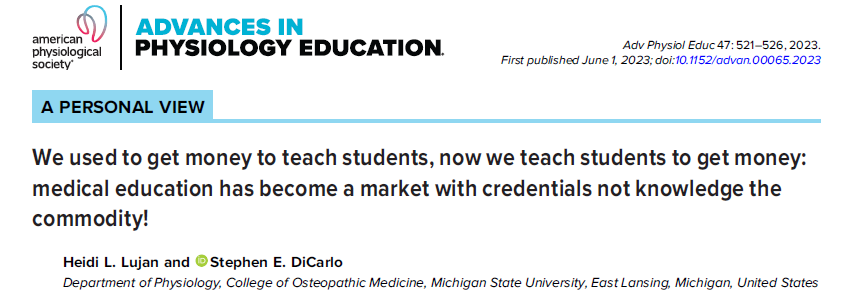I started teaching first-year medical students for a course called Medical Immunology twelve years ago. After observing and assisting my soon-to-be predecessor for a time, I took over the course, and I had almost complete control over the curriculum, lectures, small-group activities, testing, and grading. Only once a year did we meet with our colleagues from other campuses to discuss what and how our students should be learning. The rest of the details were left up to each site director, and decisions were made locally based on their own experiences, talents, and preferences.
Consequently, my students knew I had this control, and understood my potential influence on their grades and their academic and clinical careers. Not surprisingly, the course was taken seriously by most. I got feedback at the end of the course in anonymous student evaluations, and although there were always a few that hated me and everything else about the course, they generally accepted that I was in charge. The constructive criticism I took seriously, and the rest I ignored. The grades at our campus were in line with the rest of the state, and our students tended to do better on their board exams, so no one was concerned about the local process, only the good outcomes.
Fast-forward twelve years and much has changed about medical education and my place in it. My course has been combined with Medical Microbiology, and is taught in a single 6-week block (it was previously once a week for the fall semester). Every decision about the course implementation is made by all the site leaders in the state, with major changes directed by school administrators who expect the curriculum to be equivalent at every site. Much of the material is prerecorded and delivered online statewide, whereas before lectures were delivered locally in-person and posted online afterwards. All of the small group cases and activities are prepared in advance, and the students are expected to come to class to work through each activity with their groups, and the instructor is basically a facilitator, not doing much teaching. Any actual teaching that occurs is in the form of optional reviews of the statewide material, either on campus or virtually.
More Pandemic Response Collateral Damage: Medical Education
The trend towards bureaucratic uniformity in medical education started before the COVID-19 pandemic, but lockdowns sent it into overdrive. The temptation for administrators was simply too great to resist, and besides, it was all done in the name of safety! As I wrote in Fear of a Microbial Planet:
Another group that took advantage of the safety culture was universities. University administrators had long dreamed of making money off of online education, and had already progressed much farther than the rest of the world in online instruction and operations. When Harvard announced in was moving all operations online on March 10th, 2020, it was only a matter of time before all other universities followed suit. Indiana University went remote on the same day, and so did the medical school, in the middle of my immunology and infectious disease course. The long-term goal of providing one instructor for each topic for the entire state, including all the regional campuses, bringing the curriculum into uniformity in order to satisfy the one-size-fits-all requirements of accreditation agencies, became much more feasible when remote learning was already justified in the name of safety.
The biggest unforeseen problem was exams. Students would have to take them online and unproctored. Some of them would inevitably cheat. For many students, this was obvious, and it made them irate. I could only agree, “I would be just as angry about this as you,” I said to them. Plans were scrapped to have in-person exams when the staff proctors revolted. They were worried about their safety. They had been watching media horror stories and their sense of risk was completely blown out of proportion. I was told the university was closing because of fears of lawsuits. They were afraid of getting sued if someone got infected on the campus and died. To my knowledge, that never happened, yet there were hundreds of lawsuits against closures and mandates.
I noticed a few other things about the students during remote learning. They were missing a lot. I could see they weren’t watching the prerecorded lecture videos, because some of them couldn’t pronounce terms correctly. They were also relying solely on third-party materials, because those were higher quality. We had entered a niche where we couldn’t compete, and the one thing we could deliver, in-person education, we weren’t delivering. Some schools tried to teach courses like Human Anatomy completely virtually. This is impossible without access to a real human cadaver. Students were paying the same massive tuition and getting a weak representation of a medical education.
Another thing they were also missing—a sense of community. I could tell in the small group sessions that they weren’t connected with one another, they didn’t have strong leadership and they didn’t push one another to succeed. They were just coasting through the year. Once two years of remote learning had been completed, it was obvious the students were more stressed when they had to learn techniques in actual clinics, and weren’t as prepared. Despite having a low-risk of severe disease, they were treated like disease vectors, when they should have been put to work helping overwhelmed nurses and physicians. One local physician, who was in medical school at the start of the AIDS crisis, told me, “We were put out there right away, covered in PPE, drawing blood of patients for testing. That’s what we were expected to do.” The physicians that will face the next pandemic will not have had that experience. And that’s a problem.
Giving Students What They Want, Not What They Need
During the pandemic administrators were simply responding to incentives, and in their case, the pandemic provided a way to overcome any objections to remote learning and bureaucratic uniformity from faculty, state legislators, etc. However, there were few open objections, in part because of a cultural shift for measuring the success of medical education on a single metric—student satisfaction. Some students had perceived that others were getting a better education on other campuses, and had demanded uniformity across all campuses. Being students, they also demanded the courses be as easy and straightforward as possible, with all of the information distilled into exactly what they “need to know.” Students have always asked for this, and now they are most certainly getting it.
It gets worse, because the administrators aren’t doing this all by themselves, and it’s not just a cultural shift. They are being actively pushed by the LCME (Liason Committee on Medical Education), the accreditation body for medical education in the United States. You want to be an accredited institution of medical education? Make the students happy, or else.
This trend is in parallel, or perhaps part of, another shift in medical education that views students as consumers seeking to purchase medical credentials, not merely high-achieving students that have earned only the opportunity to pursue them. A recently published article by Heidi Lujan and Stephen DiCarlo of Michigan State University finally puts the consumer model of medical education and collective experiences of myself and many colleagues in stark perspective.

The article contains a lot of gems, and the abstract gets right to the heart of the problem. The credentials are the commodity and the students are the consumers:
Administrators and students are increasingly considering preclinical medical education as a market with credentials (access to USMLE Step 1 or COMLEX Level 1) the commodity and students the consumers. Consider that, once banned, for-profit medical schools are on the rise in the United States. In response to these changes, medical schools are adopting corporate models, cutting costs, and seeking profit-making opportunities. One example is the broadcasting of content to multiple sites and satellite campuses. In addition, the customers need to feel satisfied with the educational experience bought for them at high tuition costs. However, providing students with what they want often happens at the expense of what they need, and administrators engage in subtle pandering to students.
“Providing students with what they want often happens at the expense of what they need,” is something I’ve said verbatim, without even knowing these authors, and I’m sure we aren’t the only ones saying it.
In addition, medical educators used to view medicine more as a calling than a career, requiring a devotion to lifelong learning, even for its own sake. That’s not encouraged anymore:
However, we are concerned because medical schools are losing their reason for education: students committed to learning rather than the singular pursuit of obtaining credentials, professors committed to educating rather than the simple transferring of information, and researchers committed to following their intellectual passions rather than corporate agendas.
The focus on bureaucratic uniformity and “simple transferring of information” results in an overreliance on technology that destroys one of the most important, yet least tangible aspects of in-person education, which is a community of students and educators:
Technology cannot, and should not, replace student-teacher interactions. Although technology can assist in the education process, it cannot substitute for teachers and students coming together. Only the teacher can recognize verbal and nonverbal cues and identify misunderstandings. Human connection cannot be overemphasized for concepts as crucial as learning complex physiological systems, and academia must remain a path to humanization, not corporatization.
The massive loss of community during the pandemic left students without the experience of accepting responsibilities outside of taking tests. In our school, clinical preceptors statewide complained that many students in the “pandemic class” had difficulties even showing up for their clinical rotations:
Furthermore, this transformation of students from citizens into “consumers” is a concern because, in this atmosphere, the importance of keeping a schedule, relating to people, and keeping commitments are underemphasized and grades become more important to students than what they learned.
It’s even worse than that! Many schools have gone completely pass/fail, in order to “reduce stress” for fragile students and a prohibition of ranking students in any way. Even the USMLE Step 1 board exam is now pass/fail. This does not reward high-achieving students, and does not reduce the stress medical students will feel in their lives; it merely delays it. They are going to have to see patients eventually and deal with physicians who are better educated and thus haven’t had their high expectations beaten out of them yet.
As a result of deemphasizing measures of achievement, students aren’t motivated to learn, even with scaled-down, CliffsNotes-style passive transfers of information:
Therefore, we must reduce our use of the passive video format because it is boring, mind numbing for students, and monotonous for teachers. Students do not learn by simply sitting, listening to the video, memorizing assignments, and spitting out answers. Students must talk about what they are learning, write about it, relate it to past experiences, and apply it to their daily lives. Students who are actively involved in learning retain information longer than when they are passive recipients of instructions. Active involvement also improves students’ conceptualization of systems and how they function and increases students’ levels of retention.
Students only want to know what they need to know for the exams, and since they are in charge, that’s ultimately the only information they are likely to get. If all they care about is what’s tested, then the tests become the sole focus. Less tangible, but arguably just as important skills are neglected:
High-stakes MCQ exams are often the only metric that counts in medical school, and many administrators are mainly concerned with test outcomes. The higher the stakes, the more students and professors focus on teaching and learning for the exam. As a result, skills that cannot be tested with a multiple choice format are not taught, and instruction starts to look like the exam. Furthermore, and understandably, students only want to prepare for material that will be tested on the MCQ exam. Of course, this neglects many life skills, including critical thinking, problem solving, communication, interpersonal skills, and compassion.
The quality of instructors goes down, too, because now teaching faculty are considered mere vessels of canned information. Who needs a tenured professor for that? There’s less need to demonstrate scholarly activity, so concepts like evidence-based medicine get shorted:
In contrast, today, in many medical schools, faculty without substantial scholarly experience are hired, nontenured streamed, to teach without a scholarly activity requirement. Nontenured streamed faculty receive lower salaries, and, of course, this reduces the expense for laboratory space and start-up expenditures. However, the scientific basis of medicine may be reduced when faculty are not engaged in research. Research encourages skepticism of convention, the use of the scientific method, and the responsibility to discover new knowledge.
It all comes back to community and finding a place where each student can face challenges to accept responsibilities and learn and demonstrate medical knowledge and clinical skills. Take these away and the quality of education quickly erodes:
The Self-Determination Theory of human motivation focuses on our students’ innate psychological needs and the degree to which an individual’s behavior is self-motivated and self-determined. Faculty can satisfy the innate psychological needs by addressing our students’ desire for relatedness, competence, and autonomy. Relatedness refers to our students’ need to feel connected to others, to be a member of a group, to have a sense of communion, and to develop close relationships with others. Competence is believing our students can succeed, challenging them to do so, and imparting that belief in them. Autonomy involves considering the perspectives of the student and providing relevant information and opportunities for student choice and initiating and regulating their own behaviors.
This isn’t just happening in medical education; it’s happening at all levels of higher education, where students aren’t trusted to accept real responsibilities and the consequences of their actions. I wince every time I hear medical students referred as “kids.” If medical students are children, when exactly do they become adults? In residency? When they are sued for malpractice?
The insistence of bureaucratic uniformity to cut costs and catering to student wants at the expense of their needs will result in an ever-increasing number of young physicians who are not fully prepared to handle independent practice. It could take a long time to correct this problem, but it has to happen. A published article that acknowledges and clearly articulates the problem is a good first step, but only the first.
Republished from the author’s Substack
Join the conversation:

Published under a Creative Commons Attribution 4.0 International License
For reprints, please set the canonical link back to the original Brownstone Institute Article and Author.









